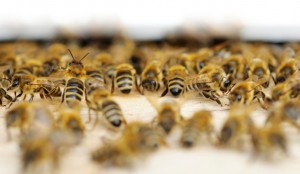06
Feb
Bee Larvae Adversely Affected by Mix of Pesticides and Inert Ingredients
(Beyond Pesticides, February 6, 2014) We know that pesticides and bees don’t mix and that particular pesticides, such as neonictinoids, pose significant threats to bee populations worldwide, but a recent study conducted by researchers at Pennsylvania State University have identified that it is “the mix” of the many chemicals in the environment that pose a significant threat to honey bee survival.
Looking at the four most common pesticides detected in pollen and wax –fluvalinate, coumaphos, chlorothalonil, and chloropyrifos, Wanyi Zhu and other researchers have assessed the toxic impacts of these pesticides on honey bee larvae at real world exposure levels; that is, levels that are found in existing hives outside of a laboratory. But these researchers go beyond the usual one-chemical analysis in their study, Four Common Pesticides, Their Mixtures and a Formulation Solvent in the Hive Environment Have High Oral Toxicity to Honey Bee Larvae. Rather than just looking at the pesticides in their individual, out-of-the-bottle form, they also mixed them up and broke them apart.
Why did they take this mixed-up approach? “Recently, one hundred and twenty-one different pesticides and metabolites were identified in the hive with an average of seven pesticides per pollen sample, including miticides, insecticides, fungicides, herbicides, and insect growth regulators,” the study explains. In other words, the average bee hive and the food that it contains for the hive population it supports has a veritable soup of pesticides ””chopped up, stirred up, and combined in every which way imaginable. It is this chemical soup that makes its way into the food for not only the adult bees, but also the developing “baby” bees known as larvae.
While it may seem an obvious step in evaluating the so-called safety of a chemical to not only look at how it interacts with other chemicals (we all remember what happens when you put vinegar and baking soda together), but also to examine its component parts for individual effects, the scary truth is that these steps are rarely taken and not required for most pesticide registrations and environmental risk assessments.
The findings of the study sent no mixed messages ””pesticides, whether looked at individually, in different combinations, or even broken down into their allegedly “inert” component parts had serious consequences on the bee larvae survival rates. “All pesticides at hive-residue levels triggered a significant increase in larval mortality compared to untreated larvae by over two fold, with a strong increase after 3 days of exposure.” The synergistic effects in most combinations of the pesticides amplified these mortality rates around the four-day mark. More concerning, however, were the results focusing on the allegedly “inert” ingredient, N-methyl-2-pyrrolidone. The study found that, “Even for the lowest concentration of [this inert ingredient], the estimated time to cause 50% larval mortality was 4 days.”
Conclusions from these findings are straightforward: pesticide risk assessments need to examine all of the mix of chemicals and their so-called “inert” parts in the environment to realistically evaluate risks on non-target pollinators. The study includes genetically-engineered crops in that mix.
Regulatory Delay Fails to Mix it Up
Unfortunately for bees and people alike, outdated and inadequate risk assessments are only one of many hurdles to much-needed change and better protections. Inert ingredients remained steeped in “trade secret” mystery and access to meaningful information concerning these ingredients is not even required under existing regulations.
Under EPA’s interpretation of the Federal Insecticide, Fungicide and Rodenticide Act (FIFRA), pesticide manufacturers are only required to list the active ingredients in a pesticide, leaving consumers and applicators unaware of the possible toxics present in the inert ingredients of pesticide products they are using, unless the EPA administrator determines that the chemical poses a public health threat. Pesticide manufacturers argue they cannot release information on inert ingredients because they are trade secrets, and, if released, their products could be duplicated. Quite often inert ingredients constitute over 95% of the pesticide product. Yet as this study and a few others are starting to show, inert ingredients are mixed into pesticides products as a carrier or sticking agent, and are often as toxic as the active ingredient.
Despite the U.S. Environmental Protection Agency’s (EPA) seeming willingness to take steps to mandate public disclosure of all inert ingredients back in 2009, EPA has taken no follow-up actions to promulgate a final rule on the issue.
Beyond Pesticides continues to advocate for improved pesticides safety standards that take into account the full-spectrum of health and environmental impacts. For more information about inert ingredients and pesticides as a whole, please visit Beyond Pesticide’s webpage, What’s in a Pesticide? Protecting pollinators will be a central theme of the upcoming 32nd National Pesticide Forum, Advancing Sustainable Communities: People, pollinators and practices, April 11-12 in Portland, Oregon.
Source: PLOS One
All unattributed positions and opinions in this piece are those of Beyond Pesticides.










